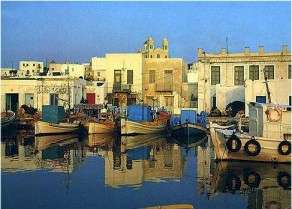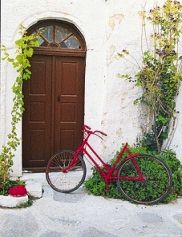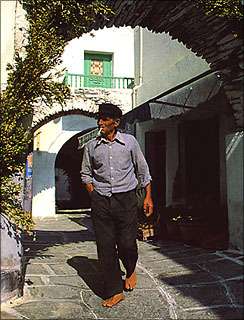
 For a small Cycladic island, Paros has a varied cultural lfe which you are
invited to share and enjoy, thus adding a colourful traditional touch to the panorama of
your holiday activities. Dance, for example, is something that everybody loves to watch.
It/s an expression of freedom, joy, high spirits (kefi) as we call it in Greek.
For a small Cycladic island, Paros has a varied cultural lfe which you are
invited to share and enjoy, thus adding a colourful traditional touch to the panorama of
your holiday activities. Dance, for example, is something that everybody loves to watch.
It/s an expression of freedom, joy, high spirits (kefi) as we call it in Greek.

Traditional dances performed by the Naoussa Dance Company will give you a
chance to join the spirit of island sounds. The Company was founded in 1988 and it now has
five dance groups which perform not only in Naoussa but in any other part of the island
that the visitor/s interest will call them. The Company also appears in various festivals
abroad, but its members will be somewhere near you during your holidays in Paros, to
show you all about Parian folklore dances, accompanied by traditional instruments such as
fiddle, lute, toumbeleki, santouri pipes, tsambouna and toumbaki.

 And
to give you a first taste, let/s describe some of the Parian dances fo you: Ageranos is
accompanied only with song, no instruments. It is based on improvisation, where the head
dancer starts the dance by singing and the others follow by repeating the verses. its
origin goes back to mythology: Theseus, on his trip back to Athens after killing the
Minotaur in Crete, stopped in Delos and visited Apollo/s temple where he sang his
adventures to the god with his companions repeating the song after him. Ageranos features
a snail-like movement, reminiscent of the labyrinth, and still retains some of its
satirical and joyful spirit. Another dance is the wedding tune which follows a meander
movement and symbolises the endless flow of the river and the perpetuation of the species
through the generations, while it also has a ritual meaning of (exorcising the
evil). A dance typical of all the islands of the Cyclades is the (ballos) with a row
of women and a row of men facing each other, a kind of traditional island courtship. Most
of these dances date their origins back to ancient Greek and Byzantine times. During the
summer, June through September, The Company performs once every ten days approximately,
while there are extra performances in other parts of the island as well as in Antiparos.
Besides folk dances, Paros offers many other culture activities. Especially in Parikia,
during the summer months, you will have the opportunity to attend concerts, some of them
performed in the courtyard of Ekatondapiliani church, and visit painting and photography
exhibitions by Greek and foreign artists.
And
to give you a first taste, let/s describe some of the Parian dances fo you: Ageranos is
accompanied only with song, no instruments. It is based on improvisation, where the head
dancer starts the dance by singing and the others follow by repeating the verses. its
origin goes back to mythology: Theseus, on his trip back to Athens after killing the
Minotaur in Crete, stopped in Delos and visited Apollo/s temple where he sang his
adventures to the god with his companions repeating the song after him. Ageranos features
a snail-like movement, reminiscent of the labyrinth, and still retains some of its
satirical and joyful spirit. Another dance is the wedding tune which follows a meander
movement and symbolises the endless flow of the river and the perpetuation of the species
through the generations, while it also has a ritual meaning of (exorcising the
evil). A dance typical of all the islands of the Cyclades is the (ballos) with a row
of women and a row of men facing each other, a kind of traditional island courtship. Most
of these dances date their origins back to ancient Greek and Byzantine times. During the
summer, June through September, The Company performs once every ten days approximately,
while there are extra performances in other parts of the island as well as in Antiparos.
Besides folk dances, Paros offers many other culture activities. Especially in Parikia,
during the summer months, you will have the opportunity to attend concerts, some of them
performed in the courtyard of Ekatondapiliani church, and visit painting and photography
exhibitions by Greek and foreign artists.

 There
are also two cinemas in Parikia and one in Naoussa, while various touring companies also
stage theatre plays. For friends of the visual arts, we recommend a visit to the ADAM
gallery. May also see the folk arts museum in Parikia, with many interesting items.
Moreover, during the summer months, there is an exhibition of Byzantine vase painting in
Parikia, while the art of pottery in general is well cultivated in Paros. There are two
pottery workshops, one in Lefkes and the other in Kostos. Artistic creativity is apparent
in every corner, the clay being transformed masterfully by the artist/s skilful hands. If
you have never witnessed this kind of creation, it is more than worthwhile to visit this
workshop and feel yourself communing in an ancient art. It would be a big omission on our
part not to mention the numerous local feasts celebrated on the island. The feast of
Ascension Day at Piso Livadi, with free seafood, wine and music, where the local boys and
girls don their traditional costumes. On the first Sunday of July, Naoussa hosts the wine
and fish festival, where lots of free wine and fish grilled on the spot is is offered to
everybody. The fun goes on till morning. On August 14 and 15th, the Assumption of
the Virgin, there is a big feast at Parikia. On August 23, nice days after the Assumption
of the Virgin, there is a big feast in Naoussa, with a representation of the pirates
assault during the times of Barbarossa. Boys dressed in traditional costumes jump from the
caiques (Fishing boats) enter the crowd and snatch the girls away. This is followed by
dance, fireworks and general merrymaking.
There
are also two cinemas in Parikia and one in Naoussa, while various touring companies also
stage theatre plays. For friends of the visual arts, we recommend a visit to the ADAM
gallery. May also see the folk arts museum in Parikia, with many interesting items.
Moreover, during the summer months, there is an exhibition of Byzantine vase painting in
Parikia, while the art of pottery in general is well cultivated in Paros. There are two
pottery workshops, one in Lefkes and the other in Kostos. Artistic creativity is apparent
in every corner, the clay being transformed masterfully by the artist/s skilful hands. If
you have never witnessed this kind of creation, it is more than worthwhile to visit this
workshop and feel yourself communing in an ancient art. It would be a big omission on our
part not to mention the numerous local feasts celebrated on the island. The feast of
Ascension Day at Piso Livadi, with free seafood, wine and music, where the local boys and
girls don their traditional costumes. On the first Sunday of July, Naoussa hosts the wine
and fish festival, where lots of free wine and fish grilled on the spot is is offered to
everybody. The fun goes on till morning. On August 14 and 15th, the Assumption of
the Virgin, there is a big feast at Parikia. On August 23, nice days after the Assumption
of the Virgin, there is a big feast in Naoussa, with a representation of the pirates
assault during the times of Barbarossa. Boys dressed in traditional costumes jump from the
caiques (Fishing boats) enter the crowd and snatch the girls away. This is followed by
dance, fireworks and general merrymaking.

On August 29 another feast takes place, that of Agios Yannis (Detis) St.
John (moorer) so called because the locals moor their boats near the monastery of the same
name. Free transfer by caiques to the site of the feast is offered to anybody wishing to
attend. At night, people camp in groups on the beach around bonfires, provided with food
and wine, and the atmosphere is full of fun which you are invited to share, enjoying the
festive island mood. Should you happen to be in Paros during Easter, make a point of
visiting Marpissa. On Good Friday you will have the chance to see the procession of the
1669 epitaph of its church. Marpissa also host representations of the Lord/s Passion
through out the Holy Week, while on Easter Sunday there are free red eggs, tsoureki (the
traditional Easter sweet loaf) and, of course, spit-roast lamb for everybody.

Send mail to webmaster@parosweb.gr
with questions or comments about this web site.
Copyright © 1998 - 1999 ® PAROSWEB SERVER!
Last modified:09/01/1999